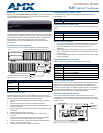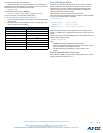
For full warranty information, refer to the AMX Instruction Manual(s) associated with your Product(s).
1/09
©2009 AMX. All rights reserved. AMX and the AMX logo are registered trademarks of AMX.
AMX reserves the right to alter specifications without notice at any time.
3000 RESEARCH DRIVE, RICHARDSON, TX 75082 • 800.222.0193 • fax 469.624.7153 • technical support 800.932.6993 • www.amx.com
93-2001 REV: B
The formula for setting the starting address is:
(DIP switch address x 12) + Card slot Number (1-12) = Card address
For example, if you set the CardFrame DIP switch to 2, the first Control Card
address would be 25. The calculation would look like:
(2 x 12) + 1 = 25.
For a sample DIP switch setting of 00010101:
(0 + 0 + 0 + 0 + 96 + 0 + 384 + 1536) + SLOT # (ex: 1) = 2017.
A card in slot number 7 would be device address 2023.
To set the CardFrame’s starting address (Device ID)
1. Set the CardFrame Number DIP switch based on the information listed in
the table below.
2. Recycle the power for approximately 5 seconds, so that the system can
read the new device number settings.
Device:Port:System (D:P:S)
A device is any hardware component that can be connected to an AXLink or
NetLinx (ICSNet) bus. Each device must be assigned a unique number to
locate that device on the bus. The NetLinx programming language allows
numbers in the range 0-32,000. Device 0 (zero) refers to the master, and
numbers greater than 32,000 are reserved.
NetLinx requires a Device:Port:System (D:P:S) specification.
This D:P:S triplet can be expressed as series of constants, variables separated
by colons, or as a DEV structure. For example:
STRUCTURE DEV
{
INTEGER Number // Device number
INTEGER Port // Port on device
INTEGER System // System device belongs to
}
The D:P:S notation is used to explicitly represent a device number, port and
system. For example, 128:1:0 represents the first port on the device TP on this
system.
If the Port and System numbers are omitted, Port #1 and System #0 (zero) are
assumed. Here's a syntax sample:
NUMBER:PORT:SYSTEM
where:
• NUMBER: 6-bit integer representing the device number
• PORT: 6-bit integer representing the port number (in the range 1 through
the number of ports on the Controller or device)
• SYSTEM: 6-bit integer representing the system number (0 = this
system)
NetLinx Device Number Conventions
NXF CardFrames typically occupy the device number range from 301 to 3072,
starting at CardFrame number (25 x 12) + 1.
CardFrame Number DIP Switch
Position Value
112
224
348
496
5192
6384
7768
8 1536




